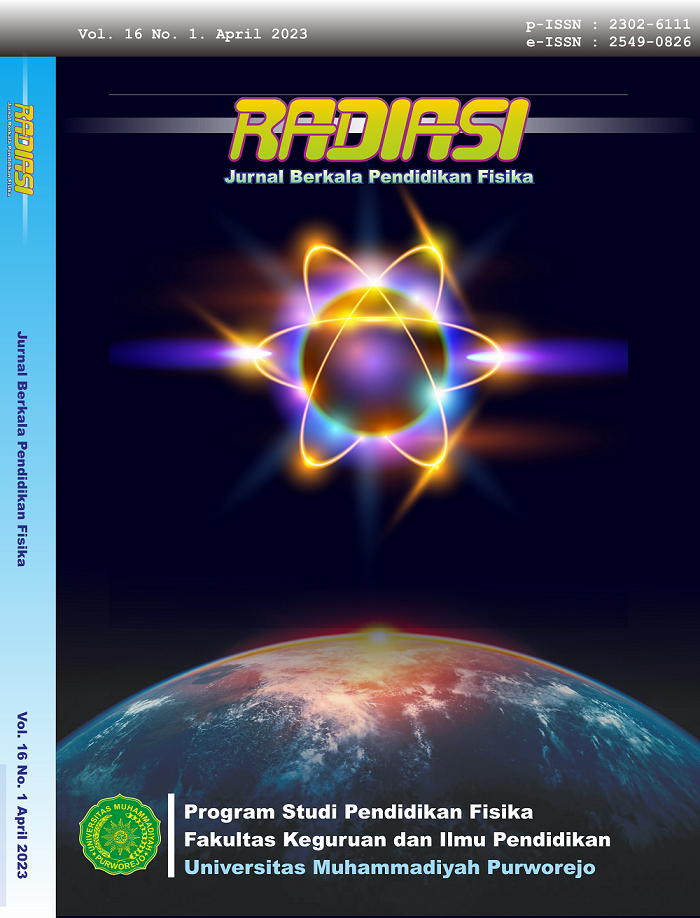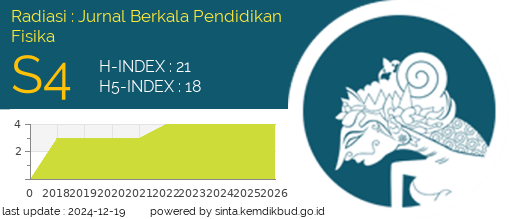The Effect of H-PBL to Improving Student’s HOTS and ICT Skills in Physics Learning
Abstract
This study aimed to analyze the effect of H-PBL to stimulating students HOTS and ICT skills. The model of H-PBL was a combination of online and direct learning. Direct learning was conducted by PBL. During online learning, the students conducted discussion through schoology applications that aimed to increase the ICT skills. The research design in this study was quantitative research with quasi-experimental type, the population that used in this study was students in 1st semester of pattern 6 in State Junior High School 5 Malang, while the sample in this study was 1 experimental class that used learning model of H-PBL and 1 control class that used learning model of PBL. The hypothesis was analyzed using the MANOVA test. The effectiveness of H-PBL learning could be known according to the improvement of learning result before and after using the H-PBL learning model and also could be known by differentiating the learning result of classes which used learning model of H-PBL dan PBL. The result of this study shown that the use of the learning model of H-PBL was proven effective in stimulating HOTS and ICT skills of students in energy materials. The analysis of this study obtained that the score of HOTS in the experimental class was 131.1 and for control class was 99.2, and the score of ICT skills in the experimental class was 18.7 while for control class was 17.8. The result shows H-PBL has effective to stimulated the student HOTS and ICT skill in Physics learning.
Downloads
References
Gunawan, A. Harjono, Hermansyah, and L. Herayanti, “Guided inquiry model through virtual laboratory to enhance students’ science process skills on heat concept,” Cakrawala Pendidik., vol. 38, no. 2, pp. 259–268, 2019.
E. Wahyuni, “Pengaruh Pemanfaatan Multimedia Dalam Pembelajaran Fisika Terhadap Pemerolehan Belajar,” J. Visi Ilmu Pendidik., vol. 7, no. 1, pp. 694–710, 2012.
H. Pratama and I. Prastyaningrum, “Pengaruh model pembelajaran project based learning berbantuan media pembelajaran pembangkit listrik tenaga mikrohidro terhadap kemampuan berpikir kritis,” J. Penelit. Fis. dan Apl., vol. 6, no. 2, pp. 44–50, 2016.
A. Oke and F. A. P. Fernandes, “Innovations in teaching and learning: Exploring the perceptions of the education sector on the 4th industrial revolution (4IR),” J. Open Innov. Technol. Mark. Complex., vol. 6, no. 2, 2020.
J. Zai, S. Ardianti, F. A. Ratnawati, and S. N. Hayati, “Implementasi Learning Manegement System (LMS) Berbantukan Edmodo untuk Meningkatkan Hasil Belajar Siswa pada Materi Fluida Dinamis,” Radiasi J. Berk. Pendidik. Fis., vol. 13, no. 1, pp. 7–13, 2020.
R. Azizah, L. Yuliati, and E. Latifah, “Kesulitan pemecahan masalah fisika pada siswa SMA,” J. Penelit. Fis. dan Apl., vol. 5, no. 2, pp. 44–50, 2015.
F. Royantoro, I. Yusuf, and S. W. Widyaningsih, “Pengaruh Model Problem Based Learning terhadap Higher Order Thinking Skills Peserta Didik,” Berk. Ilm. Pendidik. Fis., vol. 6, no. 3, pp. 371–382, 2018.
R. Fauziah, A. G. Abdullah, and D. L. Hakim, “Pembelajaran saintifik elektronika dasar berorientasi pembelajaran berbasis masalah,” Innov. Vocat. Technol. Educ., vol. 9, no. 2, pp. 165–178, 2017.
S. Salsabila, “Radiasi : Jurnal Berkala Pendidikan Fisika Development of Physics Edutainment Website to Improve Students ’ Critical Thinking Skills During the Covid-19 Pandemic,” vol. 14, no. 1, pp. 11–22, 2021.
A. Purwanto et al., “Studi Eksploratif Dampak Pandemi COVID-19 Terhadap Proses Pembelajaran Online di Sekolah Dasar,” EduPsyCouns J. Educ. Psychol. Couns., vol. 2, no. 1, pp. 1–12, 2020.
M. Habibbulloh and Madlazim, “Penerapan metode analisis video software tracker dalam pembelajaran fisika konsep gerak jatuh bebas untuk meningkatkan keterampilan proses siswa kelas X SMAN 1 sooko mojokerto,” J. Pendidik. Fis. dan Apl., vol. 4, no. 1, p. 15, 2014.
H. D. Ayu, U. Syagita, and A. Jufriadi, “Pengaruh Model PembelajaranJust In Time Teaching (JITT) Terhadap Penguasaan Konsep Ditinjau Dari Motivasi Belajar Siswa,” J. Pengajaran MIPA, vol. 24, no. 1, 2019.
Hermawanto, S. Kusairi, and Wartono, “Pengaruh blended learning terhadap penguasaan konsep dan penalaran fisika peserta didik kelas X,” J. Pendidik. Fis. Indones., vol. 9, no. 57, pp. 67–76, 2013.
A. R. Hamdani, “Pengaruh blended model problem based learning terhadap kemampuan pemecahan masalah dan pemahaman konsep siswa pada materi daur air,” J. Pendidik. guru Sekol. dasar, vol. I, no. 1, pp. 48–66, 2015.
E. Wahyuni, “Pengaruh pemanfaatan multimedia dalam pembelajaran fisika terhadap pemerolehan belajar,” Junal visi ilmu Pendidik., pp. 694–710, 2011.
A. Jufriadi, H. D. Ayu, and H. Y. Pratiwi, “Developing E-Scaffolding Integrated with E- Assessment to Improve Student ’ s Mastery of Concept,” 2019, vol. 287, no. Icesre 2018, pp. 176–179.
I. R. Katz and A. S. Macklin, “Information and communication technology ( ICT ) literacy : integration and assessment in higher education,” no. May, 2013.
S. Mawaddah and R. Maryanti, “Kemampuan pemahaman konsep matematis siswa SMP dalam pembelajaran menggunakan model penemuan terbimbing (discovery learning),” EDU-MAT J. Pendidik. Mat., vol. 4, no. 1, pp. 76–85, 2016.
Copyright (c) 2023 Akhmad Jufriadi, Hena Dian Ayu, Riski Endah Setyawati

This work is licensed under a Creative Commons Attribution-NonCommercial 4.0 International License.




